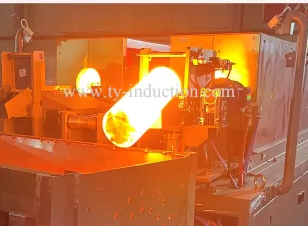May. 24, 2023
Machinery
In the realm of forging, the use of induction heating systems has revolutionized the manufacturing process. These advanced systems employ electromagnetic induction to heat metal components rapidly and precisely, resulting in improved productivity, enhanced material properties, and reduced energy consumption. In this article, we will explore the benefits and applications of induction heating systems for forging, highlighting their role in shaping the future of metal fabrication.

Induction heating Equipment utilize the principle of electromagnetic induction to generate heat within metal components. A high-frequency alternating current is passed through a copper coil, creating a magnetic field that induces electrical currents, known as eddy currents, within the workpiece. These eddy currents generate heat through resistance, rapidly raising the temperature of the metal part.
Induction heating systems offer remarkable efficiency and energy savings compared to traditional heating methods such as gas furnaces. The direct transfer of energy from the electromagnetic field to the workpiece ensures quick and precise heating without the need for intermediate heating media. This eliminates heat loss associated with conduction or convection, resulting in higher energy efficiency and reduced heating times. Moreover, the on-demand heating capability of induction systems minimizes standby energy consumption, further contributing to energy savings.
One of the key advantages of induction heating systems for forging is their ability to provide precise temperature control. The heating process can be tailored to meet specific temperature requirements, ensuring optimal material properties and avoiding overheating or underheating. This level of control is critical for achieving uniform heating, preventing material distortion, and ensuring consistent quality in the forged components.
Additional resources:Induction heating systems offer superior metallurgical outcomes in the forging process. The rapid and localized heating provided by these systems minimizes the risk of overheating or prolonged exposure to high temperatures, reducing the likelihood of grain growth, oxidation, and other heat-related defects. Consequently, the resulting forged components exhibit improved mechanical properties, such as increased strength, hardness, and dimensional accuracy.
Induction heating systems find wide-ranging applications in the forging industry. They are utilized for heating various types of metals, including steel, aluminum, and copper alloys. Induction heating is employed in processes like billet and bar heating, preheating prior to forging, post-forging heat treatment, and stress relieving. These systems offer flexibility in terms of heating pattern, allowing for precise and localized heating of specific areas on the workpiece.
The efficiency and speed of induction heating machine systems contribute to significant improvements in productivity. The rapid heating rates enable shorter cycle times, leading to increased throughput and reduced production costs. Additionally, the instantaneous heating capability eliminates the need for preheating or slow heating ramps, further reducing overall process time. With induction heating, manufacturers can achieve faster production rates, enhanced process control, and reduced downtime.
Induction heating systems offer environmental benefits compared to traditional heating methods. The absence of fossil fuels eliminates harmful emissions, reducing the carbon footprint associated with forging operations. Moreover, the energy efficiency of induction systems translates to reduced energy consumption, contributing to sustainability initiatives and cost savings.
Induction heating systems have revolutionized the forging industry, offering efficient, precise, and environmentally friendly heating solutions. With their ability to provide rapid heating, precise temperature control, and enhanced material properties, these systems have transformed the way metal components are manufactured. The versatility, increased productivity, and reduced downtime associated with induction heating make it a valuable technology for various forging applications.
Additional resources:Related Articles
If you are interested in sending in a Guest Blogger Submission,welcome to write for us!
All Comments ( 0 )